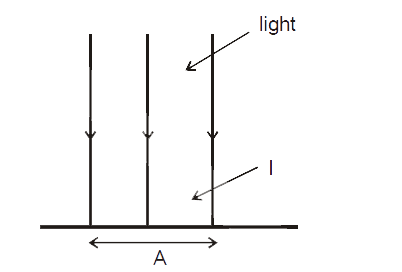Light with wavelength λ=0.55μm from a distant point source falls normally on the surface of a glass wedge. A fringe pattern whose neighbouring maxima on the surface of the wedge are separated by a distance Δx=0.21mm is observed in reflected light. Find:
(a) the angle between the wedge faces,
(b) the degree of light monochromatism (Δλ/λ) if the fringes disappear at a distance l≈1.5cm from the wedge's edge.
(a) For normal incidence we have using the above formula
Δx=λ2nα
so α=λ2nΔx=3' on putting the values
(b) In a distance l on the wedge there are N=lΔx fringes.
If the fringes disappear there, it must be due to the fact that the maxima deu to the component of wavelength λ coincide with the minnima due to the component of wavelength λ+Δλ. Thus
Nλ=(N−12)(λ+Δx) or Δλ=λ2N
so Δλλ=12N=Δx2l=0.2130=0.007.
The answer given in the book is off byu a factor 2.
Topper's Solved these Questions
- OPTICSBOOK - IE IRODOV, LA SENA & SS KROTOVCHAPTER - OPTICSEXERCISE - Diffraction Of Light
60 Videos
- OPTICSBOOK - IE IRODOV, LA SENA & SS KROTOVCHAPTER - OPTICSEXERCISE - Polarization Of Light
43 Videos
- OPTICSBOOK - IE IRODOV, LA SENA & SS KROTOVCHAPTER - OPTICSEXERCISE - Exercise
2 Videos
- MECHANICSBOOK - IE IRODOV, LA SENA & SS KROTOVCHAPTER - MECHANICSEXERCISE - Mechanics Problems
92 Videos
- OSCILLATIONS AND WAVESBOOK - IE IRODOV, LA SENA & SS KROTOVCHAPTER - OSCILLATIONS AND WAVESEXERCISE - Electromagnetic Waves, Radiation
36 Videos
Similar Questions
A plane light wave with wavelength λ=0.60μm falls normally on the face of a glass wedge with refracting angle Θ=15∘. The opposite face of the wedge is opaque and has a slit of width b=10μm parallel to the edge. Final:
(a) the angle Δθbetween the direction to the Fqaunhofer maximum of zeroth order and that of incident light,
(b) the angular width of the frqunhofer maximum of the zeroth order.
View SolutionA beam of light having wavelength λ and intensity 1 falls normally on an area A of a clean surface then
find out the number of photon incident on the surface.

View Solution
Knowledge Check
A beam of light of wavelength 600 nm from a distant source falls normally on a single-slit, 1 mm wide, and the resulting diffraction pattern is obtained on a screen 2.0 away. The distance between the first dark fringes on either side of the central bright fringe is
A1.2 mmB1.2 cmC2.4 cmD2.4 mmA parallel beam of white light is reflected from a thin wedge shaped film. The colour of the fringe at the edge of the wedge will be
AwhiteBredCblackDviolet
A plane light wave with wavelength λ=0.50μm falls normally on the face of a glass wedge with an angle Θ=30∘. On the opposite face of the wedge a transparent diffraction grating with period, d=2.00μm is inscibed, whose lines are parallel to the wedge's edge. Find the angles that the direction of incident light froms with the directions to the principle Fraunhofer maxima of the zero and the first order. waht is the highest order of the spectrum? At what angle to the direction of incident light of the observed?
View SolutionDiffused monochromatic light with wavelength λ=0.60μm falls on a thin film with refractive index n=.5. Determine the film thickness if the angular separation of neighbouring maxima observed in reflected light at the amgles close to θ=45∘ to the normal is equal to ∂θ=3.0∘.
View SolutionTwo coherent plane light waves propagating with a divergence angle ψ<<1 fall almost normally on a screen. The amplitudes neighbouring maxima on the screen is equal to Δx=λ/ψ, where λ is the wavelength.
View SolutionA plane light wave falls on Fresnel mirrors with an angle α=2.0 between them. Determine the wavelength of light if the width of the fringe on the screen Δx=0.55mm.
View SolutionFind the wavelength of monochromatic light falling normally on a diffraction grating with period d=2.2μm if the angle between the directions to the Fraunhofer maxima of the first and the second order is equal to Δθ=15∘.
View SolutionA plane monochromatic light wave with wavelength λ falls on the surface of a glass wedge whose faces from an angle α<<1. The plane of incidence is perpendicualr to the edge, the angle of incidence is θ1. Find the distance between the neighbouring fringe maxima on the screen placed at right angles to reflected light.
View Solution
